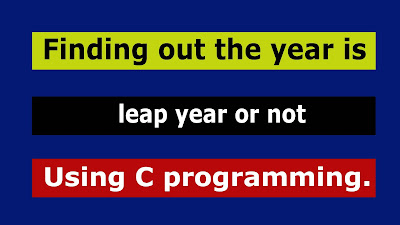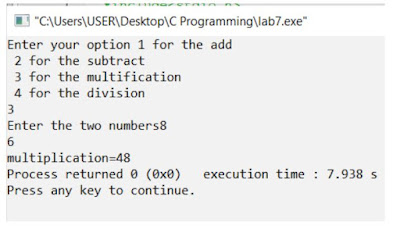Problem : Finding out the year is leap year or not.
Solution:
Introduction: In this problem, we found out the smallest number among the three numbers . Three
numbers were given by the user as the input through C programming by using codeblocks. Each
instruction in a C program is written as a separate statement. C has no specific rules for the position
at which a statement is to be written in a given line. That’s why it is often called a free-form
language. #include is a preprocessor directive. Then we used int main ( ) with a {}. We used it to
start our programming We used printf ( ) to show data, information etc. on the screen. We used
scanf for taking input from the user. We used int here to take a number. Here, y was a varriable
for the year which was given by the user.
Code:
#include<stdio.h>
int main (){
int y;
printf("Enter the year:");
scanf("%d",&y);
if ( y%4 == 0 )
printf("%d is a leap year",y);
else printf ("%d is not a leap year",y);
}
Output:
Discussion: We successfully run the program by using codeblocks. Here, we took y=2012, which
was a leap year and was seen on the display automatically and the result was absolutely correct.
And if the user gave a year which was not leap year, then we could see on the screen that the year
was not leap year. So, we could see that by using C programming we can calculate anything
without any possibility of any kind of error.
Problem: Converting temperature from Celsius to Fahrenheit and vise versa.
Solution:
Introduction: In this problem, we converted temperature from Celsius to Fahrenheit and vise
versa. Three numbers were given by the user as the input through C programming by using
codeblocks. Each instruction in a C program is written as a separate statement. C has no specific
rules for the position at which a statement is to be written in a given line. That’s why it is often
called a free-form language. #include is a preprocessor directive. Then we used int main ( ) with a
{}. We used it to start our programming We used printf ( ) to show data, information etc. on the
screen. We used scanf for taking input from the user. We used int here to take three varriables.
Here, p,q and r were three numbers which were given by user.
Code:
#include<stdio.h>
int main (){
float c,f ;
int x;
printf ( "press one for Fahrenheit to Celsius conversion \n
Press two for the Celsius to fahrenheit :");
scanf (" %d", & x);
if (x==1) {
printf("\n enter the temperature in Fahrenheit ");
scanf("%f",&f);
c=((f-32)*5)/9;
printf("\n the temperature in celsius is %.2f",c);}
else if
(x==2) {
printf("\n the temperature in Celsius");
scanf("%f",&c);
f=((c/5)*9)+32;
printf("\n thetemperature in Fahrenheit is %.2f",f); }
}
Output:
Discussion: We successfully run the program by using codeblocks. Here, we gave option to the
user to choose what conversion he/she wanted and the value of the temperature. Then the converted
value of the tempature was seen on the display automatically and the result was absolutely correct.
So, we could see that by using C programming we can calculate anything without any possibility
of any kind of error.
Problem: Finding out addition , substraction , multiplication, division of two numbers by using switch case.
Solution:
Introduction: In this problem, we found out addition, substraction, multiplication, division of two
numbers by using switch case two numbers through C programming by using codeblocks. Each
instruction in a C program is written as a separate statement. C has no specific rules for the position
at which a statement is to be written in a given line. That’s why it is often called a free-form
language. #include is a preprocessor directive. Then we used int main ( ) with a {}. We used it to
start our programming We used printf ( ) to show data, information etc. on the screen. We used
scanf for taking input from the user. We used int here to take three variables. Here, a and b are two
numbers which were given by user and o is for the option which is given by user.
Code:
#include<stdio.h>
int main(){
int a,b,o;
printf("Enter your option 1 for the add\n 2 for the subtract\n 3
for the multification\n 4 for the division\n");
scanf("%d",&o);
printf("Enter the two numbers");
scanf("%d %d", &a,&b);
switch (o) {
case 1:
printf("addition=%d",a+b);
break;
case 2:
printf("subtraction=%d",a-b);
break;
case 3:
printf("multiplication=%d",a*b);
break;
case 4:
printf("division=%d",a/b);
break;
default:
printf("your option is wrong");
break; }
}
Output:
Discussion: We successfully run the program by using codeblocks. Here, we pressed 3 for the
option to multiply two numbers. we took a=8 and b=6 and the bigger number was 78 which was
seen on the display automatically and the result was absolutely correct. And if the user gave other
options, it could show the other operations too. So, we could see that by using C programming we
can calculate anything without any possibility of any kind of error.
Problem : Finding out the eligibility to vote.
Solution:
Introduction: In this problem, we found out one is eligible or not to vote through C programming
by using codeblocks. Each instruction in a C program is written as a separate statement. C has no
specific rules for the position at which a statement is to be written in a given line. That’s why it is
often called a free-form language. #include is a preprocessor directive. Then we used int main (
) with a {}. We used it to start our programming We used printf ( ) to show data, information etc.
on the screen. We used scanf for taking input from the user. We used int here to take one variable.
Here, i is for the option which is given by user.
Code:
#include<stdio.h>
int main()
{
int i;
printf("Enter your option 1 for more or equal for 18 \n 2 for
less then 18 age:");
scanf("%d",&i);
switch(i){
case 1:
printf("eligile");
break;
case 2:
printf("not eligible");
break;
default : printf("your option is wrong");
}
}
Output:
Discussion: We successfully run the program by using codeblocks. Here, we took option 2
which was seen on the display automatically and the result was absolutely correct .So, we could
see that by using C programming we can find any grade by putting the mark without any possibility
of any kind of error.









Post a Comment